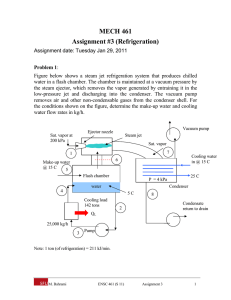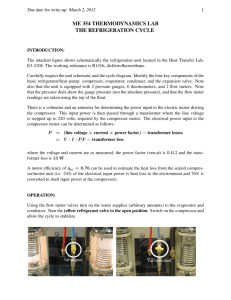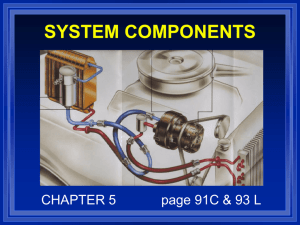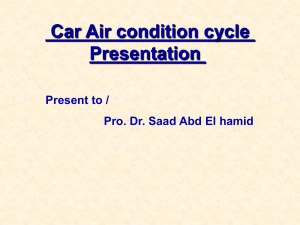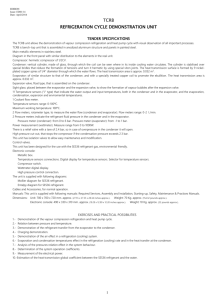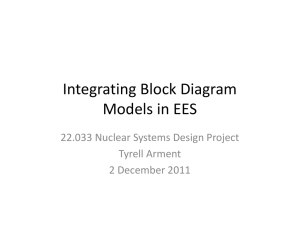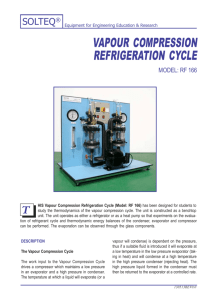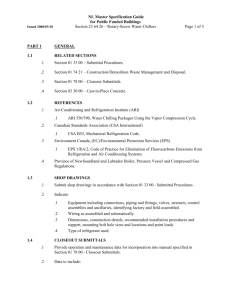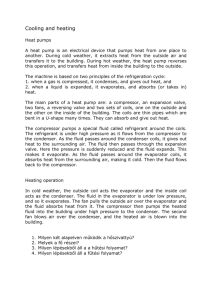Refrigeration Cycle Lab: Thermodynamics Experiment & Analysis
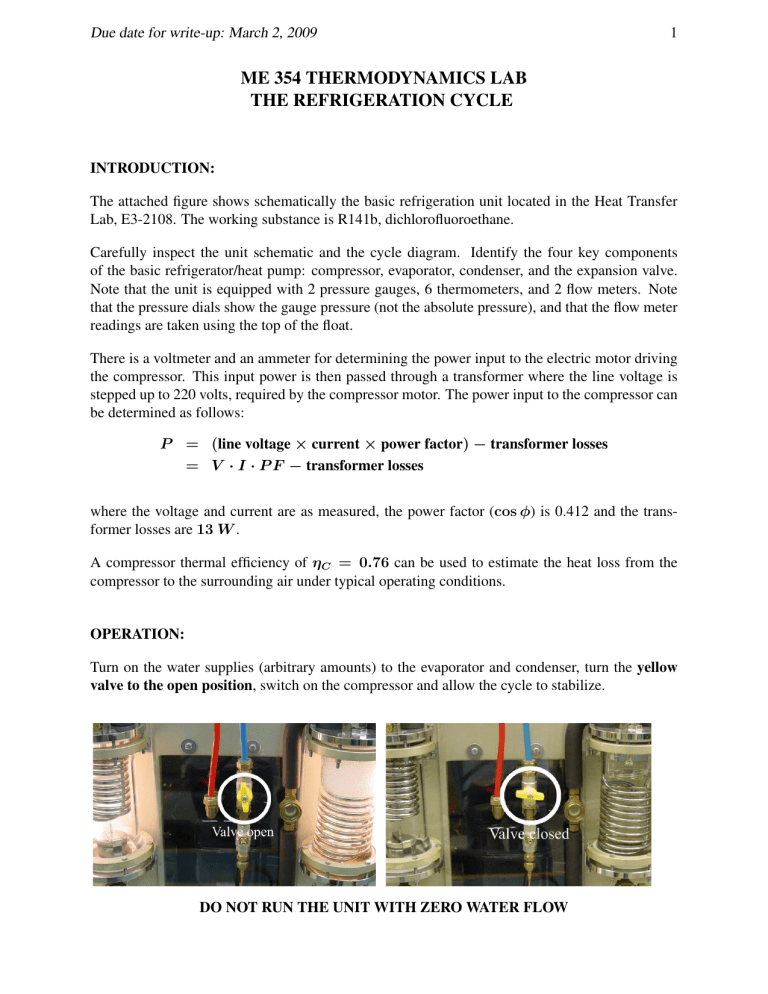
Due date for write-up: March 2, 2009
ME 354 THERMODYNAMICS LAB
THE REFRIGERATION CYCLE
1
INTRODUCTION:
The attached figure shows schematically the basic refrigeration unit located in the Heat Transfer
Lab, E3-2108. The working substance is R141b, dichlorofluoroethane.
Carefully inspect the unit schematic and the cycle diagram. Identify the four key components of the basic refrigerator/heat pump: compressor, evaporator, condenser, and the expansion valve.
Note that the unit is equipped with 2 pressure gauges, 6 thermometers, and 2 flow meters. Note that the pressure dials show the gauge pressure (not the absolute pressure), and that the flow meter readings are taken using the top of the float.
There is a voltmeter and an ammeter for determining the power input to the electric motor driving the compressor. This input power is then passed through a transformer where the line voltage is stepped up to 220 volts, required by the compressor motor. The power input to the compressor can be determined as follows:
P = ( line voltage × current × power factor ) − transformer losses
= V · I · P F − transformer losses where the voltage and current are as measured, the power factor ( cos φ ) is 0.412 and the transformer losses are 13 W .
A compressor thermal efficiency of η
C
= 0 .
76 can be used to estimate the heat loss from the compressor to the surrounding air under typical operating conditions.
OPERATION:
Turn on the water supplies (arbitrary amounts) to the evaporator and condenser, turn the yellow valve to the open position , switch on the compressor and allow the cycle to stabilize.
DO NOT RUN THE UNIT WITH ZERO WATER FLOW
2
Carefully observe the following processes in the cycle. If you are the last group of the day, return the valve to the closed position when your testing is complete.
• Process 1 - 2: The compressor creates a relatively low pressure in the evaporator and a relatively high pressure in the condenser.
• Process 2 - 3: In the condenser, the refrigerant condenses at high (in relative terms) pressure and temperature while rejecting energy to the water flowing through the coil. Thus the water is heated, producing the heat pump effect. Heat transfer between the condenser and the surrounding air can be estimated using Newton’s Law of Cooling given as Q = hA ∆ T , where
Q is the heat transfer in watts, h is the heat transfer coefficient ( W/m 2 K ) for convective cooling from vertical surfaces and A is the exposed surface area of the condenser in square meters. To simplify calculations, the heat transfer between the condenser and the surrounding air is estimated to be Q cond
= 0 .
8( T air
− T cond
), where the difference in temperature between the condenser and the surrounding air dictates the direction of heat flow.
• Process 3 - 4: The high pressure liquid leaves the condenser through a float controlled expansion valve. The pressure drop in the valve causes some of the liquid to flash into vapour, resulting in a two-phase flow which can be observed through the sight-glass located along the return line to the evaporator.
• Process 4 - 1: In the evaporator, the refrigerant boils at low pressure and temperature while removing energy from the water flowing through the coil. Thus, the water is chilled, producing the refrigeration effect. Again using Newton’s Law of Cooling, the heat transfer between the evaporator and the surrounding air can be estimated as Q evap
= 0 .
8( T air
− T evap
), where the magnitude of the temperature in the evaporator as compared to the surrounding air temperature will dictate the direction of heat flow.
THE TASK:
Using the attached table of “OBSERVATIONS”, record the room temperature and pressure, and all instrument readings after the unit stabilizes at arbitrarily chosen water flow rates between 5 g/s and the maximum available amount. You are strongly encouraged to perform more than one test, preferably over a wide range flow rates.
1. Calculate the COP (=benefit/cost) of the unit as a Refrigerator and as a Heat Pump. State your assumptions clearly.
2. Calculate the mass flow rate, ˙ , of the refrigerant. State your assumptions clearly.
3. Determine P, h and T values for all states 1-4, and show the cycle on a neatly drawn P − h diagram.
4. One lab report should be submitted for each group of two students. When preparing your lab report, it is important to be clear in your message, thorough but brief, with a typical report not exceeding 20 pages. (including all calculations, figures and graphs)
Note: For convenience, calculations can be presented in hand written form.
3
5. Approximately 60% of the mark for the lab will be given for a clear, accurate presentation of the cycle analyses described in points 1-3. The remaining 40% of the mark will be given for a demonstration of understanding beyond the basic calculations.
Try to be creative here.
This will include but is not limited to the following:
• a sensitivity analysis of the measured data, for instance, what effect does our inability to accurately measure temperatures with standard thermometers have on the calculated value of COP.
• why do the experimental results differ from a typical textbook analysis of a refrigeration cycle? Elaborate on the relevant sources of error in our experimental apparatus. While conducting the lab, try to devise procedures for quantifying sources of error.
Refrigeration Cycle Demonstration
4
Schematic Diagram
5
OBSERVATIONS:
Room Temperature ( T a
) =
Barometer =
=
Electrical power to run the compressor motor
Voltage =
Current =
Test No.
Evaporator Gauge Pressure, P e
( kN/m
2
)
Evaporator Temperature, T e
(
◦
C )
Evaporator Water Flow Rate, ˙ e
( g/s )
Evaporator Water Inlet Temp., T
1
(
◦
C )
Evaporator Water Outlet Temp., T
2
(
◦
C )
Condenser Gauge Pressure, P c
( kN/m 2
)
Condenser Temperature, T c
(
◦
C )
Condenser Water Flow Rate, ˙ c
( g/s )
Condenser Water Inlet Temp., T
4
(
◦
C )
Condenser Water Outlet Temp., T
3
(
◦
C )
1
◦
C in.Hg
kN/m 2
V
A
2 3
6

